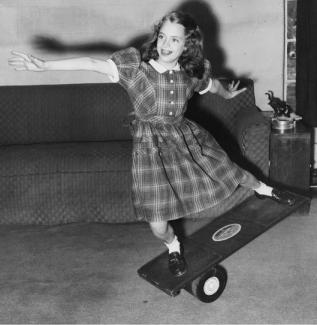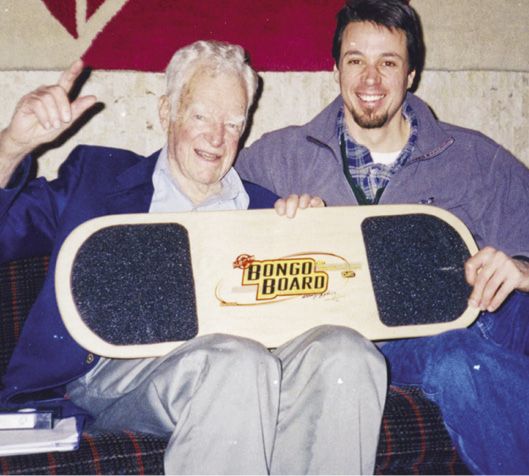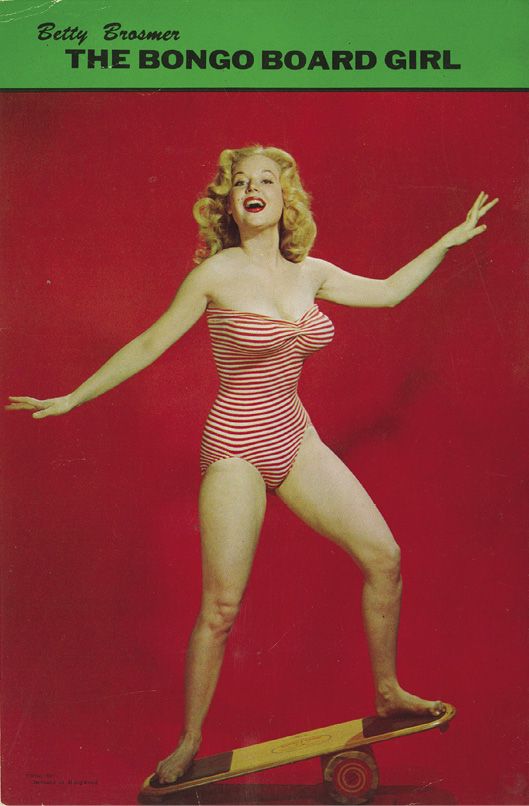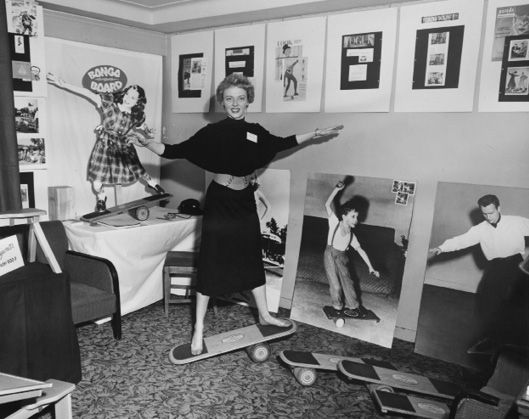Equipment: Bongo Board!

How a kid's toy became a medical-rehab device.
Picture this common après-ski scene from the 1950s and ’60s: siblings competing to see who could balance the longest on a plank of wood atop a roller, complete with a Chubby Checker record to encourage the gyrations.
We’re talking, of course, about the Bongo Board, one of snowsports’ most endearing, if marginally relevant, inventions.
Photo top: In 1952, Nina Washburn asked her father for a toy that none of her friends had, and was soon balancing on the first Bongo Board. All photos courtesy Bruce Moscarello.
“We were on it all the time,” recalls Jennifer Gasperini of Minneapolis, a flight attendant for Sun Country Airlines. “My parents bought one for our ski house at New Hampshire’s Loon Mountain because they heard it built muscles for skiing. This was back when you didn’t have a TV in your ski house—it was all about drinking hot chocolate with mini-marshmallows, playing board games, singing songs and listening to Simon and Garfunkel or the theme from Dr. Zhivago. It was a thing all our friends wanted to try. Years later, I had to get one for our kids. My son Will, now 25, played the violin on it.”
While balance boards are a major training tool used to this day by physical therapists to treat athletes and sports enthusiasts, the popularity of the Bongo Board as home entertainment has faded.
Mountains of Memories
A recent online survey of skiers and snowboarders of a certain age unleashed a blizzard of fond Bongo Board recollections.
Dave Dodge—an NCAA All-American skier for the University of Vermont and later chief engineer for Rossignol and Burton Snowboards, and founder of Dodge Ski Boots—considered the Bongo Board a valuable balance-training device. “My brother and I used to watch whole episodes of Star Trek on Bongo Boards without touching down,” he says.
Veteran ski instructor and award-winning writer Peter Shelton, now retired in Bend, Oregon, says proudly, “Still got one. For a father-daughter dance at my daughter’s wedding, we tandem Bongo-ed to the Fleetwood Mac song, ‘Go Your Own Way.’”
Bongo Boards were a featured attraction at a Madison Square Garden ski exposition in the early 1970s. Law Zabriskie, an educator and epidemiologist at New York University and a top instructor at Killington Resort, remembers winning an award at the ski show in his early teens by holding a downhill tuck on a board for more than 30 minutes. “Ouch,” he says. “I was young and really skinny but won some free equipment.”
Life of High Adventure

Circus acts have used roller boards since the rola-bola was created by the French juggler François Vasque in 1898. The Bongo Board was the invention of WWII pilot Stanley Washburn, Jr. Son and namesake of a WWI war correspondent, Washburn was fated to a life of high adventure. After graduating from Yale in 1931, he became a Navy aviator and, among other things, learned to fly blimps, which the navy used for coastal patrol. Back in civilian life, he tried to launch a commercial airship service; that idea cratered with the Hindenburg disaster in 1936. A talented writer like his father, he also contributed to pilot-training publications and wrote children’s books.
After Pearl Harbor, at age 33, Washburn was considered too old for air combat and instead piloted cargo planes for the Army’s Air Transport Command. In 1942, during a stopover in the Gold Coast (now Ghana), he spotted children playing balance games on a plank atop a sawed-off tree round. According to David Maisel, posting to Wikimedia Commons, Washburn later saw kids in India balancing on purpose-cut lumber. The idea of roller-board balance training for pilots and athletes, or just for fun, stuck with him.
After the war, Washburn became a marketing executive for Pan American Airlines, flying around the world for his job. According to Rick Contrata, writing for the U.K.–based UBalance Balance Boards, Washburn cobbled up the first Bongo Board in December 1952, after his daughter Nina asked for a toy no other child in the neighborhood would have.
In 1953 he applied for a patent on a “roller-board device.” His design differed from the rola-bola with a pair of safety innovations: To keep Nina from flying off into the furnishings, Washburn wanted to keep the board from slipping off the roller. He put a rail on the bottom of the board that fit into a groove around the roller; he also put stops at the ends of the board to keep it from rocketing off lengthwise. These boards quickly became popular among skiers and surfers to polish balancing skills.
A competing product sold mid-century was the Paul Bunyan Balance Board. Printed on the board was a sketch of Bunyan and his blue ox, Babe, balancing on boards and logs. The board was aimed at “kids from six to sixty” and was “safe, easy, healthy, fun,” according to a current listing online. It had no stabilizing rail, just four rubber bumpers to limit the roller travel.
Bongo, Bingo!

The earliest-known published mention of the Bongo Board is in the article “This Game Is Tough” in a 1953 issue of Parade magazine. One image pictures Washburn on the set of the CBS variety program The Garry Moore Show, displaying the board to the host. Then there’s “Bongo Board Causes Stir” in the November 1953 issue of Ski Magazine, in which Washburn timed a woman’s first ride, according to Rick Contrata of UBalance.
In her New York Times review of holiday gift catalogs in December 1955, Marybeth Weinstein recommends “bongo boards, to encourage spiritual as well as physical balance.” Bongo Boards were also pitched to fashionable ladies as a way to firm up legs and associated body parts. Dorothy Hawkins writes in The New York Times of February 10, 1957, “Toning up leg muscles is child’s play for this bongo-board enthusiast in her cotton jersey exercise or play suit.”
The narrator of a newsreel featuring California bathing beauties observes, “By using Bongo, bingo! Everything shapes up nicely. Yes sir, these gals are falling for Bongo in a big way.”
Home Run in Playboy
As his own publicist, Washburn hit it out of the park when he got a Bongo Board included in a Playboy centerfold. DeDe Lind, the 20-year-old Playmate of the Month for August 1967, demonstrated that a Bongo Boarder needed no protective clothing. She received more fan mail than any Playmate before or after, according to Joan Acocella’s article, “The Girls Next Door” in The New Yorker (March 6, 2006).
Bongo advertisements encouraged skiers to get fit on the board and not to “take a chance clobbering yourself the first time on the slopes this season.”
Selling for $13.50 to $16.50 (approximately $76–$96 today), the boards were endorsed by skiing influencers of their time, including Friedl Pfeifer of the Aspen Ski School and Willy Schaeffler, coach of the University of Denver Ski Team. Users were promised “slim hips and thighs,” and “year-round family fun and exercise.”
Washburn’s patent expired in 1973, but the Bongo Board stayed in production until 1980 when, with the death of his business partner, Washburn folded the Bongo Board Corporation, according to Contrata. At age 72, Washburn retired to help his wife catch and neuter feral cats on Martha’s Vineyard.
Board Reborn

The spirit of the original Bongo Board was resurrected in 1990 by two brothers, Paul and Bruce “Brew” Moscarello, located in Westchester County, New York, and central Vermont, respectively.
Their company, Vew-Do Balance Boards, applied for a patent in 1991 for a “snowboard simulator” featuring a rockered board and tapered roller, so it could rock and roll. The brothers introduced it the next year at the Action Sports Retailer trade show in San Diego.
As the Vew-Do brand grew, president Brew Moscarello was mentored by Stanley Washburn. “The first time I met him was at the Yale Club in New York,” says Moscarello now an Orvis-endorsed fly-fishing guide in Arlington, Vermont. “Stan’s initial reaction was, ‘What the hell do you want to make those things for?’ But he started taking me seriously when I said I already had several employees and was selling it. I’d visit him in Manhattan a couple of times a year. He was very supportive and had great stories, like the time he had Hugh Hefner riding [a Bongo Board]. Most of his sales were to the ski industry.”
When Thomas Staudter of The New York Times took notice of Vew-Do in a profile of the company (December 24, 1995), sales and production at its Manchester Center, Vermont, factory had more than doubled annually in the previous three years. Joint promotions at trade shows with the Vermont Ski Areas Association helped spur this growth. In 1997, the company signed its 100th dealer.
Moscarello also acquired rights to the Snurfer brand and befriended its creator, Sherman Poppen (considered the “godfather of snowboarding”), who gave his blessings for bringing the Snurfer back to market.
Today, Vew-Do boards, based upon many of Moscarello’s original designs, and Snurfer brands are sold by Snurfer, LLC, a family-owned and operated business in Spring Lake, Michigan. The company’s classic boards, which spin, tilt and simulate other boarder tricks without snow, are available for $165 to $187.
After an extraordinary life of adventure and innovation, Washburn died in 2005 at the age of 96.
A Popular Training Device
Occasionally, you’ll still get a glimpse of balance boards in the media. As recently as July 7, 2024, on CBS Sunday Morning, a professional cliff diver on the Italian stop of the Red Bull Cliff Diving World Series was shown using one to warm up.
Although one rarely hears about the original Bongo Board today, balance boards are now a staple at sports-training centers and physical therapy facilities worldwide. Dozens of companies market more than a hundred types. Go to any physical therapist and you’re likely to see balance boards made by companies such as Fitterfirst, INDO, Revbalance, URBNFit and Yes4All.
“I could see how the old Bongo Board toy led to more advanced balance board designs today,” says Kyle Willets, who holds a doctorate in physical therapy from Ithaca College and owns Alpine Fit in Boulder, Colorado. “We have about four balance boards and use them [in rehab] for all types of injuries, especially ankle and foot sprains, strains and fractures. It’s good for stabilizing the spine and core-stability work.”
Balance boards may indeed help with balance training, motor coordination, building core strength and brain development. But that’s all rather clinical stuff. It’s more entertaining to think about the board that started it all and the kids’ games, après-ski parties and Playboy centerfolds it inspired. 
Jeff Blumenfeld, of Boulder, Colorado, is vice president of ISHA and author of Travel with Purpose: A Field Guide to Voluntourism (www.travelwithpurposebook.com) An immediate past president of the North American Snowsports Journalists Association, he is a kidney patient advocate following a transplant last year. (www.jeffskidneysearch.com).